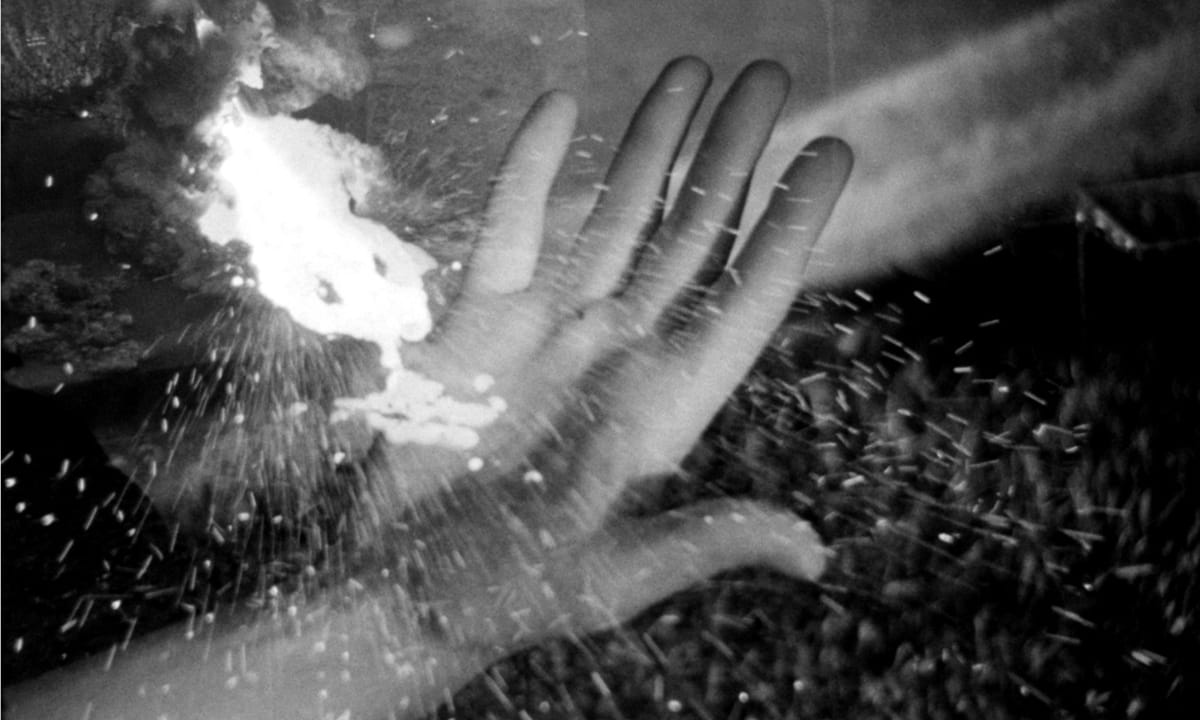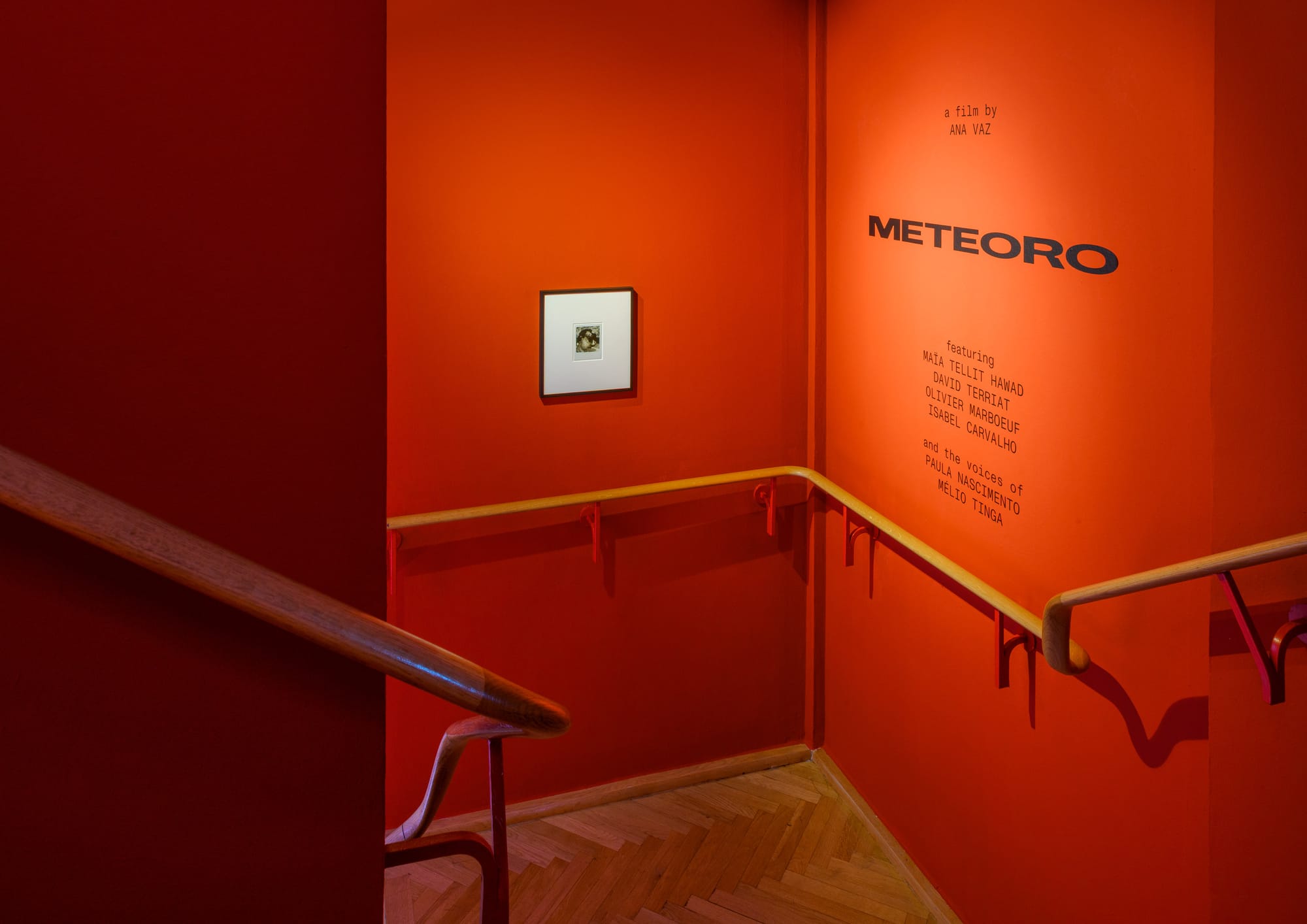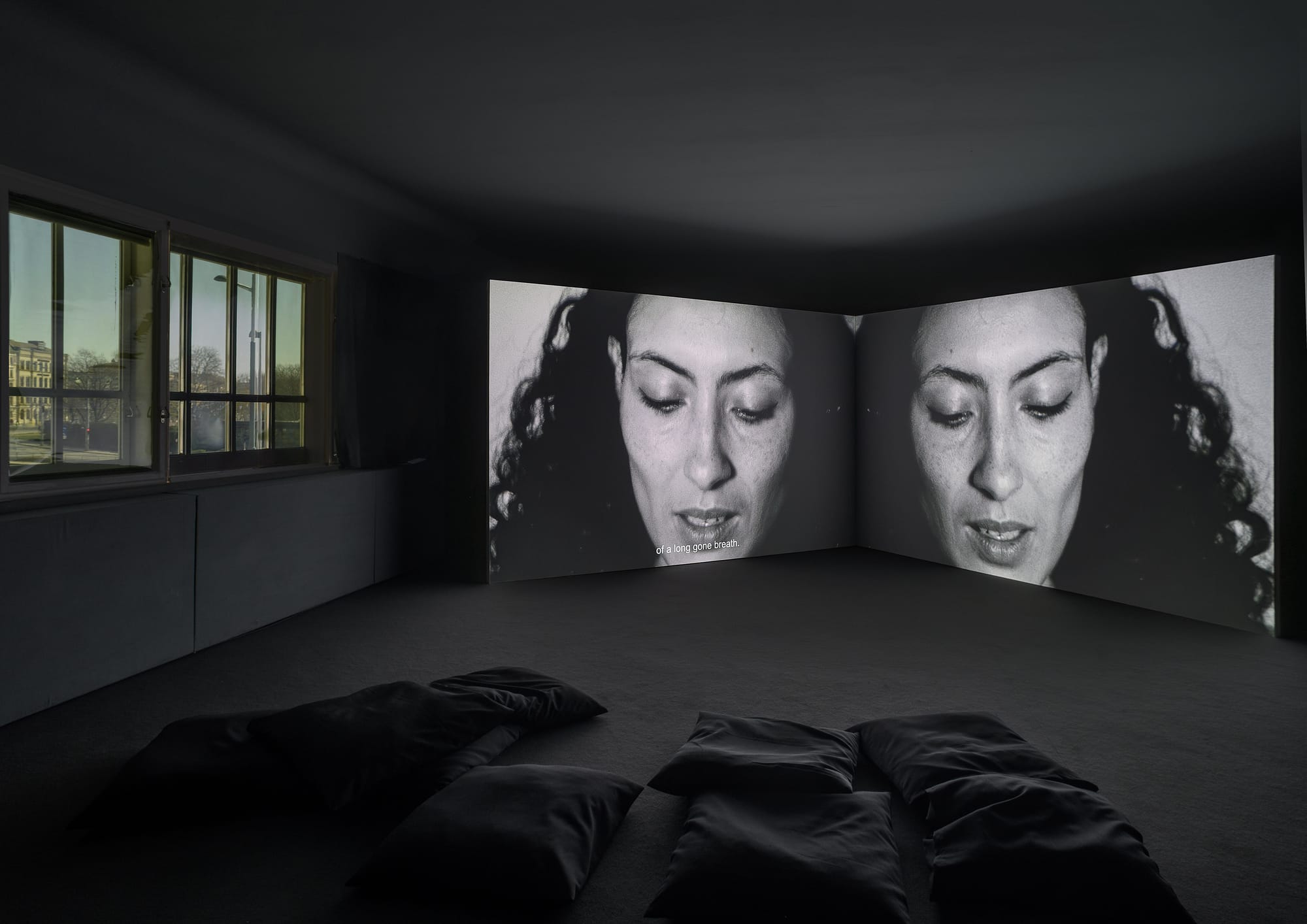
You hear Meteoro before you see it. To access the latest installation by Brazilian artist/filmmaker Ana Vaz, you climb the narrow stairway from the entrance floor of Vienna’s historic Secession Building, up to the ‘Grafisches Kabinett’, the smallest and darkest of the gallery’s exhibition spaces, and the only one with windows overlooking the busy Naschmarkt area. The Secession, an architectural landmark in the city, was established in 1897 and is one of the world’s oldest independent exhibition venues expressly dedicated to contemporary art.
The sound from the Kabinett echoes harshly around the hard walls of the stairway as you ascend. Depending on when you approach during the three-film cycle’s 51-minute loop, this may include a voice speaking in French, or Portuguese, the two languages deployed in the piece. As I made my way up, I could hear a woman speaking French, but could not make out the words.

Entering the Kabinett itself, I saw the speaker: Maïa Tellit Hawad, a Marseille-based French-Tuareg researcher/philosopher. Her face was doubled and mirrored, as the main element of the installation consists of two large free-standing screens placed at right-angles to each other, a few metres away from the entrance doorway.
Two digital projectors beam images (originally shot on monochrome 16mm) onto these large, free-standing screens. Depending on where you stand, another probably inadvertent mirroring can be discerned via the black plastic placed over the windows, only partially preventing daylight from entering.
Large black bean bags in one corner and an adjoining long bench invite seated contemplation; the ideal place to sit is directly opposite the point where the two screens meet, thus maximising the aesthetic impact of what is displayed. Sometimes the two screens show different images; sometimes they mirror each other; sometimes they both show the same image, one alongside the other.

Vaz – who first achieved renown via shorts such as A Idade da Pedra (2013), Occidente (2015) and Apiyemiyekî? (2020), before a bigger breakthrough with her 66-minute É Noite na América (It Is Night in America, 2022), which premiered in the Cineasti del Presente competition at Locarno Film Festival – switches between these formats in a way which feels more instinctive and organic than mathematical or strictly structured.
Meteora itself is a compendium of three discrete segments of varying length, separated by short periods of black screen with streaks of white scratches on the original celluloid: Paris, St Lazare runs 23 minutes, then come Os Últimos Habitantes [The Last Inhabitants] and Déesse [Goddess], both 14 minutes apiece.
The installation brings together images, sounds and narrated text in a dreamy kind of collage, one of considerable sensory impact, but whose intention and meaning only become apparent via supplementary, explanatory notes:
Predominantly focusing on Paris and Porto, European cities are depicted as on the verge of collapse or on the path to extinction. Meteoro sketches a critical anthropology of contemporary Europe, revealing the negative imprint of an Empire founded upon colonial violence, displacement and waste. Shot with high-contrast black-and-white stock the work assumes the form of a fictive archaeology. Split across three chapters, the films posit what the artist calls a “counter-ethnography” of European cities whereby the landmarks and infrastructures of a Western world are reflected and refracted as if seen in a mirror.
This reflection and refraction allows Vaz to present Paris, one of the world’s most filmed and photographed cities, in an arrestingly unfamiliar way. And she does so by relatively simple means: two street scenes are juxtaposed, both evidently shot from moving vehicles. Both are presented upside down; one image plays forward, the other in reverse. The Porto sequences likewise include moments of casual transcendence: the flowing, rippling, sun-dappled water of the Douro River is mirrored against itself, yielding pulsating patterns of sublime beauty.
Vaz’s considerable strengths as a visual poet are further illustrated by sequences showing funfair rides; the spinning sparks from a smelting works; a prowling jaguar – sometimes involving double-exposure and superimposition. In this way Meteoro is punctuated with flights of pictorial inspiration, though how such passages connect with the piece’s ambitions to be ‘a critical anthropology of contemporary Europe’ remains opaque. Vaz’s soundscapes of hissing, cranking machinery and ominous industrial rumblings further heighten the intensity of the experience delivered in this warm little room.
In terms of written poetry, or rather poetic-sounding text, Vaz seems to be less accomplished. The narrated passages provide more distraction than embellishment or elucidation. A polyphony of speakers deliver scads of airy verbiage, much of it obscurely mystical. ‘Crystal holds you in a permanent jetlag’ is one characteristically gnomic pronouncement among many. Perhaps Meteoro is the victim of inelegant subtitling, or maybe something is lost in the translation from Portuguese and French.
But the piece becomes more rewarding the less you attempt to grapple with the intricacies of the words themselves, and the more you tune your ear so that the voiceover becomes simply another part of the sonic environment. Much of Vaz’s work to date has directly connected with that most inescapably urgent of 21st century artistic themes: post-colonialism (the exhibition materials note how Vaz believes in the capacity of cinema for the ‘decolonization of the mind’). The installation’s disjoint between soaring imagery and earthbound monologue points to a post-verbal as well as post-colonial future – a ‘farewell to language’ indeed.
Departing the Grafisches Kabinett and heading down the staircase, my eye caught two ‘minor’ elements of the show which I somehow had not noticed on my way up: a pair of framed, ‘hand-manipulated’ Polaroid photographs on facing walls. On the left: Les Main, Négative, an enigmatic image of a handprint on what looks like a large rock, its title a reference to Les Mains, Négatives, the 2012 short which Vaz co-directed with Julien Creuzet (and which itself borrows its title from Marguerite Duras’ short Les mains négatives [1978]). Facing it: Hippopotamus Saxum (i.e. ‘stone hippopotamus’), in which the silhouette of the creature’s head is clearly discernible amid various strokes of artistic intervention. This latter photo encapsulates Vaz’s vision at its strange, exotic, intriguing best. No text or explanation required, the art allowed to speak for itself.
